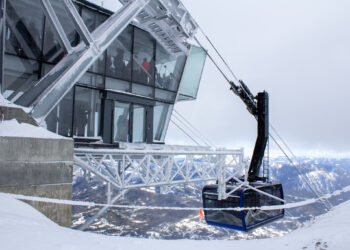By Jessianne Wright EBS Contributor
BOZEMAN – As a part of a multi-year plan to reintroduce bighorn sheep into areas of the Madison Mountain Range east of Ennis, Montana Fish, Wildlife and Parks plans to join researchers at Montana State University this winter to relocate approximately 25 bighorns. The project is tentatively scheduled for December or January, pending snow conditions and sheep counts.
Should the relocation occur, family groups will be moved from a herd of healthy bighorns wintering north of Quake Lake. The sheep will be introduced into the Wolf Creek drainage, some 10 to 12 air miles north of the capture site, using a method known as drop-net capture. A large net is suspended over a bait site and can be released in order to capture entire family groups.
“It’s a really nice way of translocating because you can get entire social groups,” said Robert Garrott in a Sept. 20 presentation at the Museum of the Rockies as a part of the Science Inquiry Lecture Series. Garrott, who designed the drop-net mechanism, is a professor in MSU’s Department of Ecology and is a leading researcher for several bighorn sheep research initiatives.
By capturing family groups, Garrott explained, biologists are able to move sheep that are already familiar with each other, which means they might be less likely to return to the capture site seeking their native range and herd.
Once the sheep have been captured, they are tranquilized and undergo a series of health panels as a part of the statewide bighorn health monitoring efforts. Some will also be collared with radio transmitters in order to study sheep behavior and mortality, and also determine the success of the relocation.
This initiative, as well as other translocation projects and monitoring efforts, comes in response to historic population declines in bighorn sheep throughout the state due to a combination of market hunting in the early 20th century, competition with livestock, and disease outbreaks that continue today.
FWP wildlife biologist Julie Cunningham says bighorn are quite unique. “I enjoy working with bighorn sheep because they take me to amazing places,” she said. “They use the landscape differently than elk or deer. Their biology is amazing: the sexual dimorphism between rams and ewes, the behaviors during rut and winter, and the wild, remote places they spend summer. They are remarkably hardy in some ways, and yet fragile in others. They use challenging terrain yet are susceptible to disease.”
According to FWP biologists, the Wolf Creek area was once native habitat to bighorn sheep. However, after several die-offs the species disappeared from the area sometime during the ‘60s.
On the Ennis side of the Madisons, there remains one population of sheep called the Taylor-Hilgard herd that winters along Quake Lake in an area known as Slide Inn, and another small band of 20 to 40 sheep that winter in the upper reaches of Moose and Sun creeks. The Spanish Peaks bighorn herd often seen near Big Sky is largely separated from these other populations in the Madison Range by areas of non-habitat.
“Bighorn sheep do not pioneer like wolves, like lions, like pronghorn, like deer, like elk. They like to stay put,” Garrott said, describing the tendency for bighorn sheep to remain in familiar areas throughout their lifetime. “So maybe if we have a vision of having bighorn sheep throughout the Madison Range, we just simply have to put them there.”
The Madison relocation initiative was approved in the fall of 2013 and has been largely funded by auction-generated dollars for bighorn sheep hunting licenses and the Pittman-Robertson Federal Aid in Wildlife Restoration funds. Fifty-two bighorns were relocated to Wolf Creek in January 2015 and a second relocation of 22 occurred the following winter in February 2016. There was no transplant last year.
Cunningham referred to the 2013 Decision Notice that authorized the Madison reintroduction plan. The notice states, “Biologically, establishing a new wintering area for bighorn in the Madison would increase biodiversity and restore a native species to known winter areas after a 50-year absence.”
“Winter range is the limiting factor for Madison bighorns,” Cunningham said. “By re-filling a historic winter range, we can see more overall sheep on the mountain. A metapopulation—several semi-isolated winter ranges—could help the overall population stay robust if a disease outbreak were to happen.”
According to an April 2017 progress report, of the pioneer group moved in 2015, about 10 to 15 remained in the area the following year, while the majority are believed to have returned to their native range. The 2016 relocation effort was much more effective, amounting to an 80 percent success rate in establishing bighorn sheep to the Wolf Creek area, as sheep have remained and dispersed into several nearby drainages.















